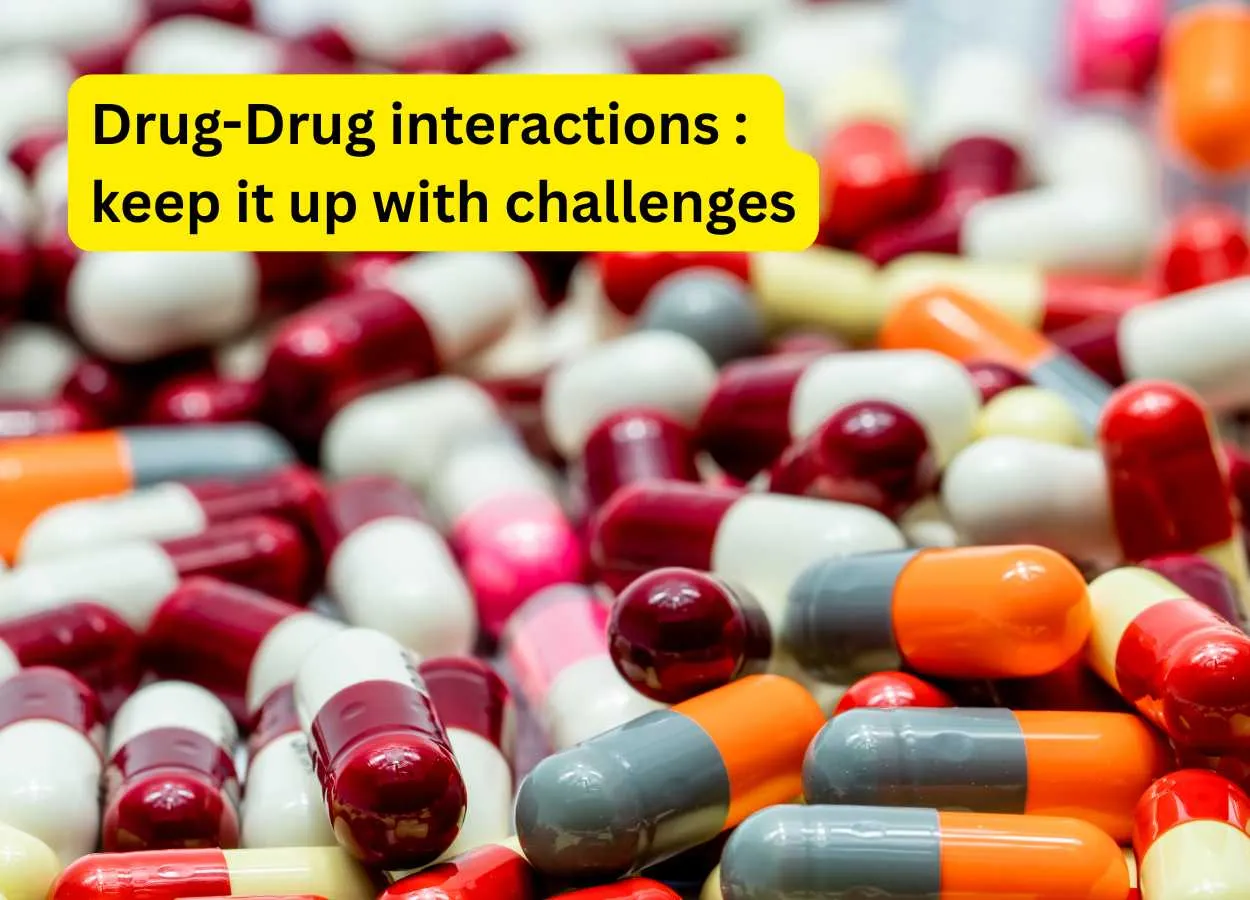Drug-Drug interactions (DDIs) are identified through a combination of clinical observation, scientific research, pharmacological knowledge, and the use of specialized tools. In clinical practice, healthcare providers assess the risk of interactions by reviewing a patient’s complete medication list, including prescription drugs, over-the-counter products, and supplements. Pharmacists and physicians rely on drug databases, electronic prescribing systems, and clinical decision support tools that automatically flag known interactions based on current evidence. Scientific identification of DDIs occurs during drug development, through in vitro and in vivo studies, clinical trials, and post-marketing surveillance. Pharmacokinetic studies help reveal how one drug may affect the metabolism, absorption, or excretion of another, often involving the cytochrome P450 enzyme system. Pharmacodynamic studies investigate how drugs may interact at the site of action, potentially enhancing or opposing each other’s effects. Additionally, large-scale data analysis, case reports, and adverse event monitoring programs (such as the FDA’s MedWatch) contribute to identifying new or rare interactions. Regular updates to clinical guidelines and databases ensure that healthcare providers have access to the latest information, helping them prevent harmful drug combinations and optimize patient safety.
Let's see some known interactions --
Warfarin + NSAIDs (e.g., ibuprofen)
Increased risk of bleeding due to additive anticoagulant and antiplatelet effects.
Benzodiazepines (e.g., diazepam) + Opioids (e.g., morphine)
Increased sedation, respiratory depression, and overdose risk.
Rifampin + Oral Contraceptives
Rifampin induces liver enzymes, reducing contraceptive effectiveness.
Grapefruit juice + Statins (e.g., simvastatin)
Grapefruit inhibits CYP3A4 enzyme, increasing statin levels and risk of toxicity.
Erythromycin + Theophylline
Erythromycin inhibits the metabolism of theophylline, increasing toxicity risk.
NSAIDs (e.g., ibuprofen) + Antihypertensives (e.g., ACE inhibitors)
NSAIDs may reduce the blood pressure-lowering effects of antihypertensives.
Beta-blockers + Beta-agonists (e.g., albuterol)
Opposing effects can reduce the effectiveness of both drugs.
Aminoglycosides (e.g., gentamicin) + Loop Diuretics (e.g., furosemide)
Increased risk of ototoxicity (hearing damage) and nephrotoxicity.
Methotrexate + NSAIDs
NSAIDs can reduce renal clearance of methotrexate, increasing toxicity (bone marrow suppression, liver toxicity).
SSRIs (e.g., fluoxetine) + Triptans (e.g., sumatriptan)
Risk of serotonin syndrome: agitation, confusion, high body temperature, muscle rigidity.
Ketoconazole + Midazolam
Ketoconazole inhibits CYP3A4, increasing midazolam levels profound sedation.
Phenytoin + Doxycycline
Phenytoin induces CYP enzymes, reducing doxycycline effectiveness.
Warfarin + Sulfonamides (e.g., sulfamethoxazole)
Sulfonamides displace warfarin from albumin higher free warfarin increased bleeding risk.
Antacids (e.g., aluminum hydroxide) + Tetracyclines (e.g., doxycycline)
Antacids bind the antibiotic in the gut, reducing absorption.
Cholestyramine + Digoxin
Cholestyramine binds digoxin in the GI tract reduced digoxin levels.
Lithium + NSAIDs (e.g., ibuprofen or naproxen)
NSAIDs can reduce renal clearance of lithium, increasing its plasma concentration and the risk of lithium toxicity (symptoms include tremors, confusion, and seizures).
Digoxin + Verapamil
Verapamil reduces renal clearance and increases the serum concentration of digoxin, which may lead to signs of digoxin toxicity such as nausea, visual disturbances, or arrhythmias.
Ritonavir (a protease inhibitor) + Various Drugs
Ritonavir is a potent inhibitor (and sometimes inducer) of multiple cytochrome P450 enzymes (including CYP3A4) and can significantly alter the levels of co-administered medications (e.g., certain benzodiazepines, statins, and anticonvulsants). This interaction requires careful dose adjustments.
Carbamazepine + Oral Contraceptives
Carbamazepine induces liver enzymes, lowering the effectiveness of contraceptives and risking unintended pregnancy.
ACE Inhibitors (e.g., lisinopril) + Potassium-Sparing Diuretics (e.g., spironolactone)
The combination can lead to increased serum potassium (hyperkalemia), which is associated with cardiac arrhythmias.
Clopidogrel + Omeprazole
PPIs, especially omeprazole, may inhibit CYP2C19—the enzyme needed to activate clopidogrel—potentially reducing its antiplatelet effect and increasing cardiovascular event risks.
Simvastatin + Amiodarone or Cyclosporine
Both amiodarone and cyclosporine can inhibit the metabolism of simvastatin, heightening the risk of myopathy or rhabdomyolysis.
Fluoroquinolones (e.g., ciprofloxacin) + Divalent or Trivalent Cations (e.g., calcium, magnesium, or iron supplements)
These cations can bind fluoroquinolones in the gut, significantly reducing their absorption and, consequently, their antibacterial effectiveness.
Tetracyclines + Dairy Products
Calcium in dairy can chelate tetracyclines, reducing drug absorption in the gastrointestinal tract.
Opioids (e.g., oxycodone) + Other CNS Depressants (e.g., sedative-hypnotics like zolpidem)
Such combinations can compound sedative effects, increasing the risk of respiratory depression and profound sedation.
Antidepressants (e.g., SSRIs) + MAO Inhibitors (e.g., phenelzine)
Although usually avoided by design, co-administration (accidental or due to insufficient washout periods) can lead to a hypertensive crisis or serotonin syndrome—a potentially life-threatening condition.
Cyclosporine + Calcium Channel Blockers (e.g., diltiazem)
Diltiazem may increase cyclosporine levels by reducing its metabolism, thereby increasing the risk of cyclosporine-induced nephrotoxicity.
Azole Antifungals (e.g., ketoconazole) + Calcineurin Inhibitors (e.g., tacrolimus)
Similar to the interaction with cyclosporine, the antifungal can raise tacrolimus levels, mandating careful monitoring of drug levels to avoid toxicity.
Metformin + Iodinated Contrast Media
While not a direct drug–drug interaction in the traditional sense, exposure to iodinated contrast in patients taking metformin can increase the risk of lactic acidosis (especially in those with renal impairment).
(Clinical guidelines recommend temporarily discontinuing metformin around the time of contrast administration.)
Beta-blockers + Calcium Channel Blockers
When used together, these drugs can excessively slow heart rate or depress cardiac contractility. Although often used in tandem for certain cardiac conditions, the combination warrants careful dose management and monitoring of cardiovascular parameters.
Warfarin + Antibiotics (e.g., metronidazole, ciprofloxacin, or trimethoprim-sulfamethoxazole)
These antibiotics can increase INR by interfering with gut flora that produce vitamin K or by inhibiting warfarin metabolism increased bleeding risk.
Warfarin + Amiodarone
Amiodarone inhibits warfarin metabolism, often requiring warfarin dose reduction.
Sulfonylureas (e.g., glipizide) + Fluconazole
Fluconazole inhibits CYP enzymes, increasing sulfonylurea levels risk of hypoglycemia.
Insulin or Secretagogues (e.g., glimepiride) + Beta-blockers
Beta-blockers can mask signs of hypoglycemia (like rapid heart rate), making it harder to detect and treat.
Valproic Acid + Lamotrigine
Valproic acid inhibits the metabolism of lamotrigine increased risk of lamotrigine-induced rash, including Stevens-Johnson syndrome.
Phenytoin + Dexamethasone
Phenytoin induces CYP3A4, increasing dexamethasone clearance reduced steroid effect.
Efavirenz + Methadone
Efavirenz induces metabolism of methadone, potentially leading to opioid withdrawal symptoms.
Ritonavir + Statins (e.g., simvastatin, lovastatin)
Ritonavir boosts levels of these statins risk of rhabdomyolysis. Safer alternatives (e.g., pravastatin) are recommended.
MAO Inhibitors + Tyramine-rich Foods (or SSRIs/SNRIs)
Can lead to hypertensive crisis or serotonin syndrome, respectively. MAOIs have many dangerous interactions.
Lithium + Thiazide Diuretics (e.g., hydrochlorothiazide)
Thiazides reduce lithium clearance lithium toxicity (tremors, nausea, confusion).
Clozapine + Carbamazepine
Both can suppress bone marrow function increased risk of agranulocytosis.
Macrolides (e.g., erythromycin, clarithromycin) + QT-prolonging Drugs
Additive effects increase the risk of Torsades de Pointes, especially in those with electrolyte abnormalities.
Linezolid + SSRIs or SNRIs
Linezolid has MAO-inhibitory properties and can cause serotonin syndrome when used with serotonergic agents.
Oral Contraceptives + St. John's Wort (herbal)
St. John’s Wort induces CYP3A4, reducing contraceptive effectiveness increased risk of pregnancy.
Levothyroxine + Iron or Calcium Supplements
Iron and calcium impair levothyroxine absorption — must be taken several hours apart.
Allopurinol + Azathioprine or 6-Mercaptopurine
Allopurinol inhibits xanthine oxidase, the enzyme that breaks down these immunosuppressants increased risk of bone marrow suppression and toxicity.
Role of Pharmacovigilance in DDIs:
Pharmacovigilance plays a vital role in identifying new DDIs by systematically monitoring, collecting, and analyzing data on adverse drug reactions (ADRs) and medication use in real-world settings. While clinical trials may detect common and predictable interactions, they are limited by sample size, controlled conditions, and short durations, often missing rare or delayed interactions. Pharmacovigilance bridges this gap by continuing the evaluation of drug safety after a product is marketed.
Advanced pharmacovigilance also employs data mining techniques and statistical algorithms to identify associations between drug combinations and unexpected adverse effects. Once a new interaction is confirmed, regulatory authorities may update drug labels, issue safety alerts, or implement risk mitigation strategies to inform healthcare providers and protect patients.
Identifying, managing, and preventing DDIs presents several challenges in clinical practice, pharmacology, and regulatory science. These challenges can significantly impact patient safety and the effectiveness of therapy. Below are the main issues:
Polypharmacy and Complex Regimens
Polypharmacy and Complex Regimens pose a significant challenge in identifying and managing DDIs. Polypharmacy—commonly defined as the use of five or more medications—is especially prevalent among elderly patients and individuals with multiple chronic conditions. As the number of medications increases, so does the risk of both known and unknown interactions, making it harder for healthcare providers to predict or detect harmful combinations.
In complex treatment regimens, drugs may be added or removed frequently, often by different healthcare providers, increasing the chance of oversight. Moreover, the cumulative effect of multiple medications can lead to additive toxicities, altered pharmacokinetics, or competing metabolic pathways, which may not be immediately apparent. This complexity also makes it difficult for clinicians to attribute specific symptoms to a particular interaction, delaying recognition and appropriate management.
Additionally, polypharmacy increases the cognitive load on both patients and providers. Patients may struggle with adherence, leading to inconsistent drug levels, which can obscure the clinical presentation of DDIs. For providers, the volume of potential interactions flagged by electronic systems can contribute to “alert fatigue,” where important warnings may be overlooked or disregarded.
In summary, polypharmacy and complex regimens amplify the difficulty of identifying, predicting, and managing DDIs, requiring careful medication review, interprofessional collaboration, and the use of robust clinical decision-support systems.
Hidden or Undocumented Medication Use
Hidden or Undocumented Medication Use is a major challenge in identifying and preventing DDIs. Many patients take over-the-counter (OTC) drugs, dietary supplements, herbal remedies, or traditional medicines without informing their healthcare providers. These substances may seem harmless, but they can significantly interact with prescribed medications, often in ways that are unpredictable or poorly understood.
This lack of disclosure may result from patients assuming non-prescription products are safe, forgetting to mention them, or not recognizing them as medications. Additionally, some patients may obtain medications from multiple healthcare providers or pharmacies, leading to incomplete or fragmented medication records. Cultural practices and language barriers can further complicate accurate reporting, especially when patients use traditional or alternative therapies.
Such undocumented use makes it difficult for healthcare professionals to perform thorough drug interaction assessments. For instance, supplements like St. John’s Wort can induce liver enzymes and reduce the effectiveness of drugs such as oral contraceptives or antidepressants. Without knowledge of its use, the resulting therapeutic failure may be misinterpreted.
To address this challenge, clinicians must take detailed and open-ended medication histories, educate patients on the importance of disclosing all substances they consume, and promote an environment where patients feel comfortable sharing their full medication use. Electronic health records and decision-support tools are only as effective as the data entered into them, making complete documentation critical for preventing DDIs.
Limitations of Clinical Trials
Limitations of clinical trials represent a significant challenge in detecting and understanding DDIs before a medication is approved for widespread use. Clinical trials, especially in early phases, are conducted in controlled environments with strict inclusion and exclusion criteria. This means they typically involve a small, homogenous group of participants—often healthy adults without multiple comorbidities or concurrent medications. As a result, these trials may not reflect real-world conditions where polypharmacy and diverse patient populations are common.
Because of their limited scope and duration, clinical trials may not capture rare, delayed, or cumulative interactions that only become apparent during long-term or widespread use. Additionally, many trials focus on evaluating the safety and efficacy of a single drug or a few specific combinations, without thoroughly investigating how the drug interacts with a broad range of other medications.
Another limitation is the underrepresentation of vulnerable populations, such as the elderly, children, pregnant women, or patients with liver or kidney dysfunction—groups that are often more susceptible to DDIs due to altered drug metabolism and clearance.
Consequently, many clinically important DDIs are only identified through post-marketing surveillance, observational studies, or spontaneous reporting systems. This highlights the critical role of pharmacovigilance and real-world evidence in supplementing clinical trial data to ensure medication safety.
Incomplete or Outdated Databases
Even though many clinical decision-support tools and electronic health records include DDI alerts, they may miss rare interactions or include outdated or overly general information, leading to alert fatigue—a phenomenon where clinicians ignore or override warnings.
Individual Variability
Individual variability is a significant challenge in predicting and managing DDIs because patients differ widely in how they absorb, metabolize, and respond to medications. These differences arise from a variety of factors, including genetics, age, weight, sex, organ function (especially liver and kidney), underlying health conditions, diet, and lifestyle.
One of the most critical aspects of individual variability is pharmacogenetics—how genetic differences affect drug metabolism. For example, some individuals may be fast or slow metabolizers due to variations in cytochrome P450 enzymes. A drug interaction that is clinically insignificant in one person may lead to toxicity or therapeutic failure in another, depending on these genetic factors.
Age also plays a role; older adults often experience reduced renal and hepatic function, altered body composition, and polypharmacy, all of which can influence the severity of DDIs. In contrast, children metabolize drugs differently, which means DDI data derived from adults may not be directly applicable to pediatric patients.
Other factors like nutritional status, smoking, alcohol use, and comorbid diseases (such as liver cirrhosis or heart failure) can further alter drug behavior in the body, affecting the likelihood and severity of interactions.
Due to these diverse variables, even well-documented DDIs may not present uniformly across all patients. This variability makes it difficult to apply a "one-size-fits-all" approach and emphasizes the need for personalized medicine, careful monitoring, and clinical judgment when managing potential drug interactions.
Lack of Standardized Guidelines
Lack of standardized guidelines is a major challenge in the identification, classification, and management of DDIs. Despite the vast amount of research and data on drug interactions, there is no universally accepted framework for assessing their clinical relevance or for guiding healthcare providers on how to respond when an interaction is identified. This inconsistency leads to significant variation in how DDIs are interpreted and managed across different healthcare systems, institutions, and even among individual clinicians.
Different drug interaction databases and clinical decision-support tools often use varying criteria to classify the severity and likelihood of interactions—some may label an interaction as “major,” while others may consider it “moderate” or even “minimal.” This inconsistency can cause confusion and contribute to alert fatigue, where providers may ignore or override warnings, potentially missing important interactions.
Evolving Drug Landscape
The evolving drug landscape presents a continual challenge in managing DDIs. With the rapid pace of pharmaceutical innovation, new drugs, biologics, and combination therapies are introduced to the market regularly. While this progress expands treatment options, it also increases the complexity of predicting how new agents will interact with existing medications.
Many newly approved drugs have novel mechanisms of action or are metabolized by pathways that are not fully understood, which makes it difficult to anticipate all potential interactions during early use. Even when preclinical and clinical trials suggest a low interaction risk, real-world data may later reveal significant or rare DDIs that were not evident during the limited scope of trials.
Additionally, the growing use of biologics, monoclonal antibodies, and gene therapies introduces new interaction challenges, as these agents may not follow traditional pharmacokinetic pathways (e.g., CYP450 metabolism), making standard DDI screening tools less effective.
Drug repurposing and off-label use further complicate the landscape, as combinations that were not initially studied may become common in practice, yet lack adequate interaction data.
Keeping up with the evolving drug landscape requires continuous updating of clinical decision support systems, drug interaction databases, and healthcare provider education. It also underscores the importance of robust post-marketing surveillance and pharmacovigilance systems to identify, assess, and mitigate emerging DDIs in a timely manner.
Communication Gaps
Communication gaps represent a significant challenge in the prevention and management of DDIs, particularly in complex healthcare systems where multiple providers may be involved in a single patient's care. These gaps can occur between physicians, pharmacists, nurses, specialists, and even between care settings such as hospitals, primary care, and long-term care facilities. When medication information is not accurately or promptly shared, the risk of unrecognized or inappropriate drug combinations increases.
One common issue is incomplete medication histories, especially during transitions of care, such as hospital discharge or referral to another specialist. If one provider is unaware of all the medications a patient is taking—particularly those prescribed by others critical interactions may go undetected. Similarly, lack of communication between prescribers and pharmacists can prevent timely intervention when potential interactions are flagged.
Electronic health records (EHRs) can help mitigate these issues, but only if they are interoperable and consistently updated. In many systems, fragmentation of records between institutions or departments leads to missing or outdated drug information. Additionally, communication challenges may arise from time constraints, unclear documentation, or differing levels of knowledge about DDIs among healthcare professionals.
Patient-provider communication is also crucial. Patients may not fully understand the importance of reporting all the medications they use, or they may forget to mention non-prescription products and supplements, contributing to incomplete medication data.









